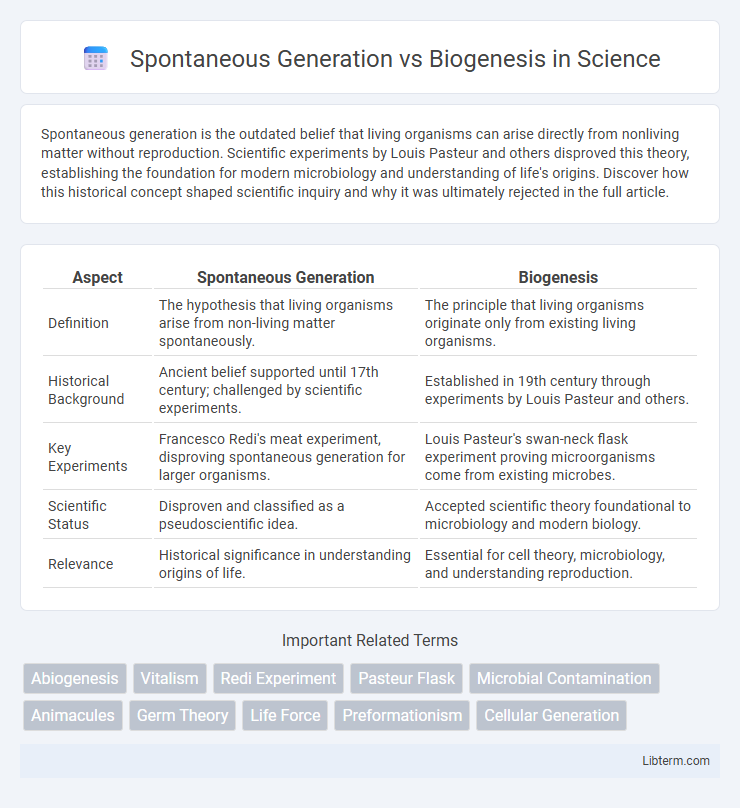Spontaneous generation is the outdated belief that living organisms can arise directly from nonliving matter without reproduction. Scientific experiments by Louis Pasteur and others disproved this theory, establishing the foundation for modern microbiology and understanding of life's origins. Discover how this historical concept shaped scientific inquiry and why it was ultimately rejected in the full article.
Table of Comparison
| Aspect | Spontaneous Generation | Biogenesis |
|---|---|---|
| Definition | The hypothesis that living organisms arise from non-living matter spontaneously. | The principle that living organisms originate only from existing living organisms. |
| Historical Background | Ancient belief supported until 17th century; challenged by scientific experiments. | Established in 19th century through experiments by Louis Pasteur and others. |
| Key Experiments | Francesco Redi's meat experiment, disproving spontaneous generation for larger organisms. | Louis Pasteur's swan-neck flask experiment proving microorganisms come from existing microbes. |
| Scientific Status | Disproven and classified as a pseudoscientific idea. | Accepted scientific theory foundational to microbiology and modern biology. |
| Relevance | Historical significance in understanding origins of life. | Essential for cell theory, microbiology, and understanding reproduction. |
Introduction to Life’s Origins
Spontaneous generation, the outdated belief that life arises from non-living matter spontaneously, was challenged by biogenesis, which established that life originates only from existing life forms. Experiments by Louis Pasteur provided definitive evidence supporting biogenesis, transforming our understanding of life's origins. This paradigm shift laid the foundation for modern microbiology and the scientific study of life's beginnings.
Defining Spontaneous Generation
Spontaneous generation is the disproven biological theory that living organisms arise from nonliving matter spontaneously without reproduction, such as maggots appearing from decaying meat. This idea was widely accepted until experiments by scientists like Francesco Redi and Louis Pasteur demonstrated that life originates only from existing life, supporting the theory of biogenesis. Biogenesis asserts that all living organisms come from pre-existing living cells, fundamentally opposing spontaneous generation.
The Legacy of Ancient Beliefs
The legacy of ancient beliefs in spontaneous generation shaped early scientific thought by asserting that life could arise from non-living matter, a concept widely accepted until the 19th century. This idea influenced the development of early biology and natural philosophy, delaying the acceptance of biogenesis, which demonstrated through experiments by Louis Pasteur and others that life originates only from existing life. The transition from spontaneous generation to biogenesis marked a pivotal advancement in microbiology, establishing foundational principles for modern biology and the understanding of life's origins.
Biogenesis: The Scientific Revolution
Biogenesis, the principle stating that living organisms arise only from pre-existing life, gained definitive support during the Scientific Revolution through experiments by scientists such as Francesco Redi and Louis Pasteur. Redi's 17th-century experiments with meat and maggots disproved spontaneous generation by demonstrating that maggots develop only when flies lay eggs on meat. Pasteur's 19th-century swan-neck flask experiments conclusively showed that microorganisms come from other microorganisms, solidifying biogenesis as a cornerstone of modern biology.
Key Experiments Challenging Spontaneous Generation
Louis Pasteur's swan-neck flask experiment in 1861 conclusively disproved spontaneous generation by demonstrating that sterile nutrient broth remained free of microbial growth when protected from airborne contaminants. Francesco Redi's 17th-century maggot experiment showed that larvae on decaying meat originated from eggs laid by flies, not from the meat itself. John Tyndall provided further evidence with his demonstration of heat-resistant bacterial spores, which explained previous contradictory results and reinforced biogenesis as the source of life.
Louis Pasteur and the Demise of Spontaneous Generation
Louis Pasteur's experiments with sterilized broth and swan-neck flasks provided definitive evidence against spontaneous generation by demonstrating that microorganisms arise from existing microbes, not from non-living matter. His work laid the foundation for the principle of biogenesis, which states that life originates only from preexisting life, fundamentally altering microbiology and disproving centuries-old beliefs. This scientific breakthrough led to the widespread acceptance of germ theory and revolutionized practices in medicine and hygiene.
Modern Evidence Supporting Biogenesis
Modern evidence supporting biogenesis emphasizes the consistent observation that living organisms arise only from pre-existing life, as demonstrated by Louis Pasteur's experiments using sterilized nutrient broths that remained free of microbial growth unless exposed to contaminants. Advances in microbiology and molecular biology have revealed complex cellular structures and genetic replication mechanisms impossible to form spontaneously from nonliving matter. Experimental findings such as the failure to observe spontaneous life formation under controlled sterile conditions reinforce the principle of biogenesis over spontaneous generation.
Ongoing Debates and Misconceptions
Ongoing debates around spontaneous generation versus biogenesis focus on the historical persistence of misconceptions despite overwhelming scientific evidence supporting biogenesis, which states that life arises only from existing life. Many misunderstandings stem from early observations lacking sterile techniques, leading to false assumptions that life could emerge spontaneously from non-living matter. Contemporary discussions emphasize clarifying that biogenesis aligns with modern microbiology and evolutionary theory, while spontaneous generation remains a disproven hypothesis.
Impact on Microbiology and Evolutionary Theory
The shift from spontaneous generation to biogenesis revolutionized microbiology by establishing that microorganisms arise from existing life, thereby enabling the development of germ theory and sterile techniques. This paradigm shift reinforced evolutionary theory by demonstrating that life forms originate from common ancestors through reproduction rather than spontaneous appearance. Consequently, biogenesis laid the foundational understanding for microbial genetics and evolutionary biology, influencing research on pathogen transmission and the origins of life.
Conclusion: The Enduring Significance of Life’s Origins
The conclusion of Spontaneous Generation vs Biogenesis highlights that biogenesis, the concept stating life arises from existing life, remains scientifically validated and underpins modern biology. Spontaneous generation, once widely accepted, was discredited through pivotal experiments by scientists like Louis Pasteur, shaping our understanding of microbiology and sterilization processes. The enduring significance lies in biogenesis's role in comprehending life's origins, supporting advances in medicine, genetics, and evolutionary biology.
Spontaneous Generation Infographic

 libterm.com
libterm.com